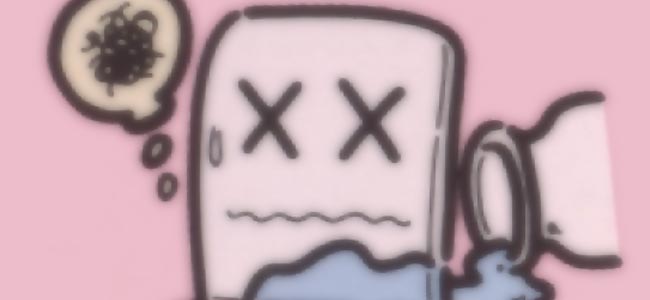 Numerous great web sites already propose complete history and technical
specifications of the PC Engine system. For this very reason, VGDen will not
fill up this page with the same old stories. Let's talk about other stuff. Let's
talk about HuCards and where they come from.
Numerous great web sites already propose complete history and technical
specifications of the PC Engine system. For this very reason, VGDen will not
fill up this page with the same old stories. Let's talk about other stuff. Let's
talk about HuCards and where they come from.
Hum, so ... I know VGDen said he will not talk about history, but he really thinks it is good to know
some of it anyway, you will see, all the rest will make much more sense, everything
will become clear and joyful. The cute
and great PC-Engine console was born from the collaboration of the Electronic giant NEC
(Nippon Electronic Corporation) and the prolific software developer Hudson Soft.
Back in 1987, NEC was a strong Personal Computer manufacturer and was seriously trying
to step in the console home world and this association with Hudson Soft was a sort of
perfect move. In Japan, Nintendo's Famicom was king and the market, even if Sega's
Master System (the SG series and Mark III) just stepped in, was certainly open for
a another player. The PC Engine is a brilliant tinny system, sleek and small,
cleverly designed and powerful, which even for today's standard, stays really
attractive for players all over the world. VGDen likes it a lot.
PC Engine games were first released using the credit card sized data
cartridge format called HuCard and was the perfect choice to fit the small
and sleek machine (Cartridges the size of Neo Geo's would have look somehow
odd don't you think ?...). We can easily assume that this format was created by Hudson Soft itself.
First because of its name, "HU" certainly standing for Hudson. But because
Hudson Soft was also a chip manufacturer and was already using a similar format, called
Bee-Card, for the MSX system.

Bee Cards, however, have fewer pins (they count 32 compared to Hucards's 38).
Hudson Soft even manufactured its own reader, called the Bee-Pack, which could be inserted in
the standart cartridge port of any MSX computer and read the slim Bee-Cards.
As you can notice, Bee-Card front prints are upside down compared to their HuCard counterpart. And the
reason is probably simple, the Bee-Pack would be inserted vertically in the MSX computer,
so the Bee-card label was facing up. The same simple idea can be applied to the Hucards, the cartridge port
of the PC Engine is at the front of the system, so it made sense to flip them (They were flipped back again
when the SuperGrafx was released because the orientation change by the way). VGDen is only guessing here,
but it is probably not far from the truth...
|
|

|
Bomberman for the japanese MSX (front & back)
- Courtesy of Tristan -
|
|
HuCards were also stored in a CD like packaging, did NEC and Hudson Soft knew
they will release games on CDs when they first released the PC Engine ? I
think so. All of this was part of a well designed plan. But let's go back to our main topic, let's talk about HuCards. Let's
see what they are made of.
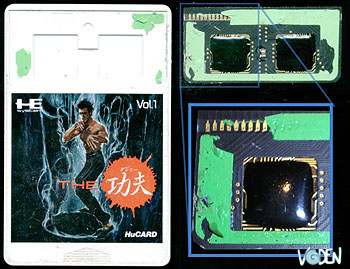
Insides of a HuCard
|
What are they made of ?
The game Rom is actually stored
in the black area, all the rest of the HuCard is just plain plastic. They could have
been even smaller, some would argue, but they wouldn't have been so practical and we would have
certainly missed all the gorgeous japanese art work. Only games like
Street Fighter 2 or Populous are supposed to have electronics in the white area of
the card, which certainly explains their thickness. As you can see on the picture
of the left, most of a HuCard is just plain plastic. Do not worry, this
HuCard did not suffer. Not as much as me who ended up hurting my thumb with a vicious and
tinny screwdriver to get those pictures...
|
The PC Engine also probably
had the first memory card ever, in the shape of a ... Hucard as you would expect.
The Tennokoe Bank (Ten-No-Koe meaning "voice from heaven" in japanese) was the
first battery-backed Hucard and could store 4 game datas (4 x 2k) on its 8K Ram.
Sadly you also needed to own either a CDRom² or a Backup Device ( the Tennokoe Bank 2 ) to store those
saved games in the first place. Just think about it, how can you save your game of
Neutopia to your Tennoke Bank when the game is already inserted in the Hucard
port ?...
Japan (Official HuCards):
Two sorts of official HuCards were available. The ones for the PC Engine system going from 2
Megabits up to 20 Megabits. Then a few were released for the SuperGrafx and only
worked for this upgraded version of the PC Engine. However, even if the system was
supposed to be backward compatible, some Hucards do not work on the SuperGrafx (like Space Harrier) and,
on the other hand, some were optimised for both systems, like Darius Plus. On the following
picture, notice how the black area of the HuCard actually increases as the game rom gets bigger.

Example of Japanese HuCards, from left to right :
Alien Crush (2 MBits) - AeroBlasters (4 Mbits) - Parodius Da ! (8 Mbits) -
Street Fighter 2' (20 Mbits) - 1941 Counter Attack (SuperGrafx)
|
Japan (Special, promotional and prototype HuCards):
Japan is the mother patrie of the PC Engine system, where everything started,
where Nec and Hudson Soft joined forces. And, logically, this is where very unusual
HuCards can be found. The most common of all, given their relative rareness, are the
special editions handed away to the winners of the yearly Caravan Competition held
in Japan from 1985, or given away in special occasions. However this competition started
on Nintendo's Famicom and later shifted to the PC Engine system in 1987. As far as I know,
there are four special HuCards : The golden All Stars Power League (1988),
the Gunhed Special Version (1989), Final Soldier Special Version (1990)
and Soldier Blade Special Version (1992). (read Super Star Soldier review
for more information).
And then, the other Holy Grail are promotional HuCards, produced in very limited
quantities and only featuring cut down versions of the original games, or just demos.
Here are the know promotional HuCards: Bomberman Users Battle (1990),
Bomberman '93 Special Version (1992) and PC Genjin 3 demo version (1992).
Finally, and not the least, here are the rarest and most expensive HuCards ever, the onces
that most of the PC Engine fans trembling fingers will never touch. The first one is the well
know Darius Alpha (1990) only offering two special modes, a "boss mode" and a
"time attack". And the second one is the not so known Youkai douchuuki Gold
(tales of the monster Path) with its golden HuCard and Packaging. The last one,
and even less known, seems to be the yellow sample HuCards handed over by Hudson Soft,
the only known example is The Kung Fu and the game is slightly different than the final
version. Surprisingly the HuCard label doesn't mention the game, it only has
HuCard and Hudson Soft written on it. But this kind of steps in
the realm of prototype HuCards, the rarest of all, the often unique pieces of history.
Not much is known about what is out there, and some appear on famous auction web sites
from time to time. But many unreleased games probably exist
as prototypes (this is also the case for most game system), and the list of known
titles that never hit the public is surprisingly long and will certainly be
the object of a special article.
|

Common and Special versions of Soldier Blade. If the
first one can be found for acceptable prices, the second
usually ask for inbetween
$200/$250 a piece.
|
USA:
American HuCards (called Turbo-Chips) only work on the American hardware. Special adapters,
the most famous being certainly the Kisado Converter, allows americans to enjoy Japanese titles on their
Turbografx 16, American version of the PC Engine. A few titles were only released in America though and some games also show
differences, like the first stage of Magical Chase or the heavily censured version
of Kato & Ken. The beautiful prints from the Japanese Hucards have also often disappeared and replaced
by bland and usually monochromatic prints. Game instructions and covers also got heavily modified
and often replaced by tasteless and poor illustrations. However, American games came in bigger
packages and had another box roughly the size of a VHS tape, just thinner, around the CD-size case.
The TurboGrafx 16 was also originally sold with the game Keith Courage in Alpha Zone,
aka Majin Eiyu Wataru in Japan.
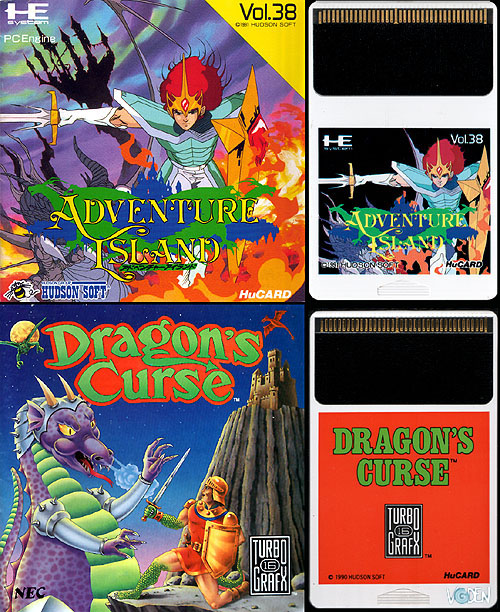
Adventure Island, renamed Dragon Curse for the American market.
As you can see, the HuCard art work was usually removed from the American
versions and the game illustration changed.
|
|
Europe:
A PAL System was released in Europe but incredibly late in the PC Engine life. The release was also
really quiet, so quiet that most of the people in Europe never heard of it ! The game included with
the console wasn't Keith Courage in Alpha Zone like in the US, but Blazing Lazers,
aka Gunhed which was obviously a much better choice.I do not think special PAL games were
ever produced though, games "officially" released are the american versions and the original video signal
was probably converted to PAL (However, I still need to verify this).
The PC Engine was nevertheless present in Europe way before the PAL version, and was available there virtually
a year or so after the Japanese release !
The PC Engine was present in England through the grey market (understand here the import market) and
like in a lot of other countries in Europe, the PC Engine was known by many players. Some Fanzines appeared like the
very interesting PC Engine Fanatics (which became later Console Ma'zine and
Electric Brain) first released in April 1989 by Onn Lee. The Fanzine, more than reviewing
tons of game, also offered translated articles and news from major Japanese video game magazines, like
PC Engine Fan, Marukatsu PC Engine or Monthly PC Engine. PC Engine games were also
reviewed in official British magazines like Edge.
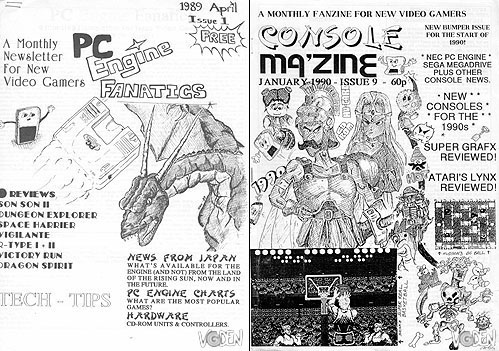
Examples of English Fanzines dedicated to the PC Engine system.
|
|
Back in France, the Japanese PC Engine was distributed by SODIPENG in 1990 (Société de Distribution
De la PC Engine/ PC Engine Distribution Company )
and offered some amazing add-ons, like the RGB and stereo audio outputs using the Peritel
format, unknown in the US. Games were also officially imported and sold by many retailers,
even including french supermarkets like Auchan. A real effort was made by SODIPENG to
import the system and make it available to the public. Game instructions were translated in
French and a simple photocopy was placed inside the game package.
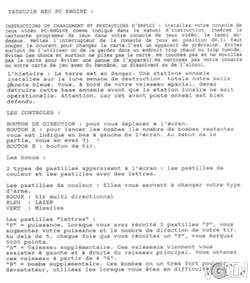
French manual for the game Tatsujin
( click to enlarge )
|
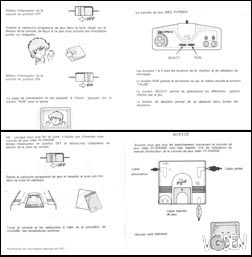
French donumentation which
was also inserted with every PC Engine
game.
( click to enlarge )
|
|
The console was also widely covered by the french video game press, like Tilt,
Joystick to only name a few. PC Engine games were reviewed and presented with all the
other systems.
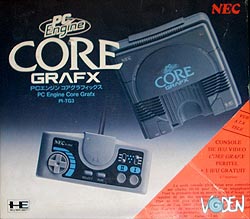
Core Grafx sold in France.
( Click to enlarge the red label )
|
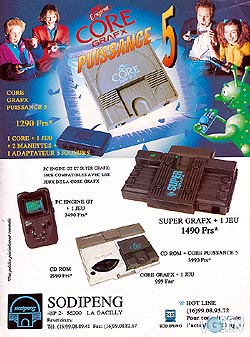
One of the numerous SODIPENG adverts.
( click to enlarge )
|
|
The PC Engine was also available in other European countries ( Germany, Spain etc...) through unofficial imports from Japan. Do not hesitate to contact me if you have more information about those.
Asia and unofficial japanese HuCards:
As for many other systems, numerous pirates and clones were released in Asia.
The most common is probably the series of cards (and also CDRoms) released by the company
Game Express. On the contrary of other company releasing unofficial games
for the PC Engine system, Game Express actually created original games, and
not copies, even if they are generaly Hentai games (understand here
game for adults). The quality of their HuCards was also good, even if the labels are often
a bit more fragile than standard HuCards.
Then come the clones. They are copies of the PC Engine hardware and
often had their own line of software, most of the time copies of
existing titles. The PC-Boy
used standard HuCards but also cards especially available for this system. Another odd
one is probably the chinese UFO Super Game system using, this time, special
cartridges and also totally incompatible with the PC Engine system. Finally,
let's not forget other weird HuCards using thick and cheap Eproms, or the 4 in 1 series
proposing several games on the same HuCard.
All of those are hard to come by, as you can guess. Even today, it is
very hard to know what is out there. Do not hesitate to read the always growing Pirate
section on VGDEN if you are interested to learn a bit more about those.
|
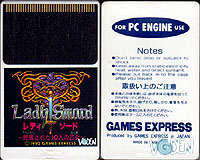
Lady Sword by Game Express
Front and back
( click to enlarge )
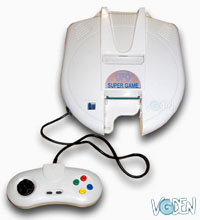
The Chinese UFO SUPER GAME Pc Engine clone
( click to enlarge )
|
The HuCard format is probably the first and most impressive feature of the PC Engine system.
How cool was it, back then, to go and visit some friends with a dozen games fitting
in the palm of your hand ? But Games on cards were not only available for the PC Engine
system, far from it. Let see what else we can find...
As mentionned, the MSX also had a few games stored on cards. The Master System also had few games
on cards. They were released in Japan around 1985 and were called Sega Mycard. A few of them
were released in
Europe and America as Sega cards. Never wondered what the slim port
of the original Master System console was for ? Here you go, this was to play the tinny Sega cards.
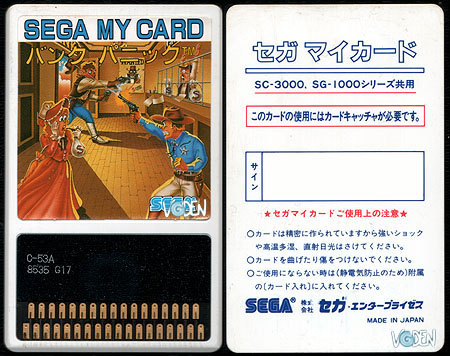
Japanese versions of Bank Panic on Sega MyCard
|
Those cards actually appeared way before the Master System (Mark III), and the Sega SG-1000 was
already offering those. You can also notive that they have tow rows of pins, 17 on the upper
row and 18 on the lower, so a total of 35 compared to HuCard's 38.
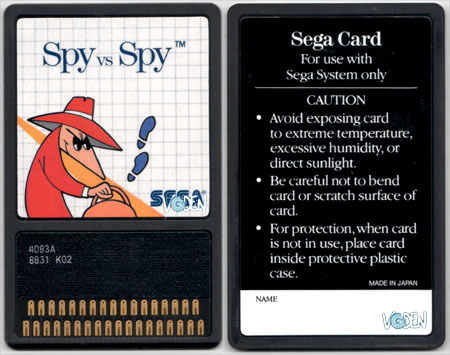
American (and European) versions of Spy vs. Spy on Sega Card
|
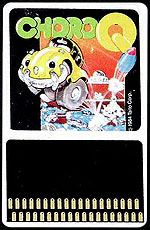
Choro Q by Taito
on MSX Soft Card.
( click to enlarge )
- Courtesy of Tristan -
|
Evenmore, other cards called Soft-Cards were also available for the MSX and needed,
like Hudson's Bee-Cards, a special cartridge reader. However those cards were nearly identical to
Sega's cards for the master system. They have the same color but they differ in their
number of spins, 19 on the upper row and 19 on the lower giving a total of 38, the same as a HuCard.
But, curiously they did
not seem to be manufactured by Sega (in Europe, they seems to have been manufactured by companies
like Electric Software and were also called Instand Load Astron SoftCard).
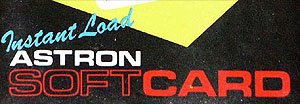
|
|
Another old computer, this time french and called the Exelvision EXL 100
and released in 1984,
used an ingenious card system, about twice as thick as a
standard HuCard. But the great originality of the system was that
every card had a switch at the back so the pins could
be easily extended or retracted. The Gamate portable system
also offered slim grey cards similar to
Sega's MyCards. The old Odyssey has cartridges that
could be considered as cards too... wait a minute ... not really isn't it ?
especially as they didn't contain any chip, just connectors.
It was back in the old days where consoles had no microprocessors nor memory.
But still, they were slim and were far from the blocky design of
a Cartridge.
|
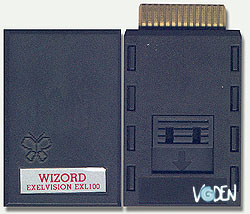
Exelvision computer card like cartridges
The card of the right has its pins extended
( click to enlarge )
|
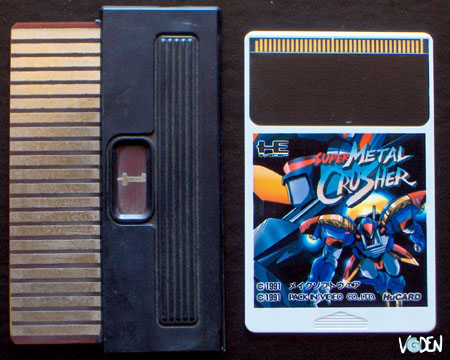
Only around 15 years separate the above two cartridges:
the Odyssey 1 on the left and the PC Engine HuCard on the right
|
|
Finally, let's end this article on something amusing. I
remember playing Namco's fantastic Katamary Damacy for
Sony's Playstation 2 for the first time. I suddenly got
stunned when I saw the Memory Cards than can be collected
in Stage 2. Don't they look familiar to you ?
I am not sure if artists at Namco did it on purpose, or
not, but they look faily similar to standard HuCards or
Msx Bee-Cards :
White cards with a black area and a single line of pins. Even
card labels have the same orientation and are not flipped like
Sega's MyCards or Msx Bee-Cards.
|
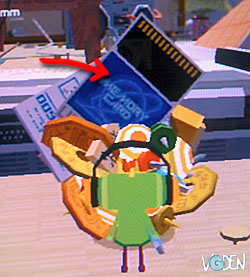
Memory Cards can be collected in
Namco's brillant Katamary Damacy
Don't they look familiar ?...
(1)
|
In late 1988, Nec released the CD-ROM² system ( CDROM square standing for CD-ROM-ROM ).
But this is another story, which will soon be told in the PC Engine CDROM² page...
All logos and trademarks
are © their respective owners.
This page content is
©2005 Video Game Den / Laurent KERMEL
|




















